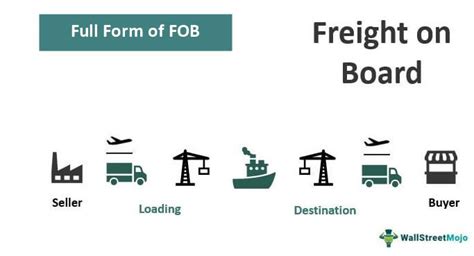Definition Of Fob Shipping Point

In the intricate world of international trade and logistics, the term FOB (Free on Board) shipping point plays a pivotal role, defining crucial aspects of the shipment process and the responsibilities of both the buyer and seller. This term is part of a set of standardized international commercial terms known as Incoterms®, which provide clarity and consistency in global trade agreements.
Understanding the FOB shipping point is essential for anyone involved in the import or export of goods, as it directly impacts the flow of goods, the allocation of risks, and the financial responsibilities of the parties involved. In this article, we will delve deep into the intricacies of FOB shipping point, exploring its definition, its practical implications, and how it shapes the landscape of international trade.
Understanding FOB Shipping Point

The term FOB shipping point is a contractual agreement between a buyer and a seller, indicating that the seller’s responsibility for the goods ends once the goods have been loaded onto the transport vehicle at the shipping point or origin. This shipping point can be a warehouse, a manufacturing facility, or any other designated location agreed upon by the parties.
The key implication of this term is that the seller is responsible for delivering the goods to the shipping point and ensuring they are properly loaded onto the transport vehicle. Once this is done, the risk of loss or damage to the goods shifts to the buyer. This transition of risk is a critical aspect of FOB shipping point, as it defines the point at which the buyer assumes responsibility for the goods.
Key Elements of FOB Shipping Point
- Transfer of Risk: As mentioned earlier, the primary significance of FOB shipping point is the transfer of risk. Once the goods are loaded onto the transport vehicle, the buyer becomes responsible for any loss or damage that may occur during transit.
- Seller’s Obligations: The seller is responsible for delivering the goods to the shipping point, ensuring they are in good condition, and loading them onto the transport vehicle. They are also obligated to provide the necessary documentation, such as the bill of lading, which serves as a contract of carriage and a receipt for the goods.
- Buyer’s Responsibilities: The buyer, on the other hand, is responsible for arranging and paying for the transport of the goods from the shipping point to their destination. This includes choosing the carrier, negotiating shipping rates, and ensuring the goods arrive safely and on time.
Practical Implications of FOB Shipping Point

The FOB shipping point term has several practical implications that both buyers and sellers should be aware of. These implications affect not only the logistics of the shipment but also the financial aspects and legal responsibilities of the parties involved.
Logistical Considerations
When using the FOB shipping point term, the seller is typically responsible for ensuring the goods are packaged appropriately for transport and loaded onto the transport vehicle. This includes any necessary preparation, such as securing the goods to prevent damage during transit.
Once the goods are loaded, the buyer takes over the responsibility for their care. This means the buyer must ensure the goods are properly insured during transit, as the seller's insurance coverage usually terminates once the goods are loaded onto the transport vehicle.
Financial Responsibilities
From a financial perspective, the FOB shipping point term has significant implications. The seller’s obligations end at the shipping point, so they are not responsible for any costs incurred during the transport of the goods. These costs, including freight charges, insurance, and any additional expenses, are borne by the buyer.
It's important to note that the seller may still have an obligation to provide certain documentation, such as commercial invoices and packing lists, which are necessary for customs clearance and payment processing. However, the financial responsibility for these documents typically rests with the buyer, who must ensure their accuracy and timely submission.
Legal and Regulatory Compliance
Using the FOB shipping point term also has legal implications. The seller must ensure that the goods comply with all relevant regulations and standards at the shipping point. This includes any necessary certifications, permits, or inspections required for the goods to be legally transported and sold.
The buyer, on the other hand, must ensure compliance with the laws and regulations of the destination country. This may involve obtaining import permits, paying customs duties and taxes, and complying with any specific requirements related to the goods' nature or intended use.
Benefits and Drawbacks of FOB Shipping Point
Like any contractual term, FOB shipping point has its advantages and disadvantages. Understanding these can help buyers and sellers make informed decisions and choose the most suitable Incoterm for their specific trade scenario.
Benefits
- Simplicity: FOB shipping point is one of the simpler Incoterms to understand and implement. It clearly defines the point at which the seller’s responsibilities end and the buyer’s begin, providing a straightforward framework for the shipment process.
- Flexibility: This term offers flexibility in terms of transport arrangements. The buyer can choose the carrier and shipping method that best suits their needs, without being constrained by the seller’s preferences or limitations.
- Cost Control: By assuming responsibility for the transport of the goods, the buyer has more control over shipping costs. They can negotiate rates with carriers, explore different shipping options, and potentially save on transportation expenses.
Drawbacks
- Risk Exposure: One of the primary drawbacks of FOB shipping point is the early transfer of risk to the buyer. This means the buyer assumes responsibility for the goods even before they are in their possession, which can be a significant risk, especially for high-value or fragile goods.
- Administrative Burden: The buyer bears the administrative burden of arranging transport, obtaining necessary documentation, and ensuring compliance with regulations. This can be a time-consuming and complex process, particularly for buyers who are not familiar with international trade procedures.
- Limited Seller Support: With FOB shipping point, the seller’s involvement ends at the shipping point. This means the buyer may not have the seller’s support or expertise in navigating the complexities of international trade, particularly if issues arise during transit or at the destination.
Comparing FOB Shipping Point with Other Incoterms
To fully appreciate the implications of FOB shipping point, it’s essential to compare it with other Incoterms, each of which offers a different set of responsibilities and benefits for buyers and sellers.
FOB vs. EXW (Ex Works)
The EXW (Ex Works) term is often compared to FOB shipping point. In an EXW agreement, the seller’s obligations are even more limited, as they only need to make the goods available at their premises or another agreed-upon location. The buyer is then responsible for arranging and paying for the entire transport process, from the seller’s location to the final destination.
While EXW provides even greater flexibility and cost control for the buyer, it also shifts the risk and administrative burden to an earlier stage. The buyer must ensure the goods are picked up from the seller's location and properly transported, which can be logistically challenging, especially for buyers located in distant markets.
FOB vs. CIF (Cost, Insurance, and Freight)
At the other end of the spectrum is the CIF (Cost, Insurance, and Freight) term. With CIF, the seller bears more responsibility, as they are obligated to arrange and pay for the transport of the goods to the port of destination, as well as obtain insurance coverage for the goods during transit. The risk of loss or damage remains with the seller until the goods are unloaded at the destination port.
CIF provides more protection for the buyer, as they are not exposed to the risks of transport until the goods arrive at the destination port. However, this increased protection comes at a cost, as the seller's involvement and responsibilities extend further into the shipping process, which can impact the overall price of the goods.
Best Practices for Using FOB Shipping Point

When deciding to use the FOB shipping point term, both buyers and sellers should consider certain best practices to ensure a smooth and successful trade transaction.
Clear Communication and Documentation
Effective communication is crucial when using FOB shipping point. Both parties should have a clear understanding of their respective responsibilities and the terms of the agreement. This includes specifying the exact shipping point, the mode of transport, and any specific requirements or instructions related to the goods or their packaging.
Proper documentation is also essential. The seller should provide accurate and detailed commercial invoices, packing lists, and any other necessary documentation to facilitate customs clearance and payment processing. The buyer, in turn, should ensure they have all the necessary documents to arrange transport and comply with regulatory requirements.
Insurance and Risk Management
Given the early transfer of risk under the FOB shipping point term, both buyers and sellers should give careful consideration to insurance. The buyer should ensure they have adequate insurance coverage for the goods during transit, as any loss or damage that occurs after the goods are loaded onto the transport vehicle is their responsibility.
The seller, while not directly responsible for transport insurance, should still consider providing insurance coverage up to the shipping point. This can help protect the seller's interests and ensure the goods are adequately protected during the initial stages of the shipping process.
Logistical Planning and Coordination
As the buyer assumes responsibility for the transport of the goods under FOB shipping point, they must carefully plan and coordinate the logistics of the shipment. This includes selecting a reliable carrier, negotiating favorable shipping rates, and ensuring the goods are properly secured and handled during transit.
The buyer should also consider potential delays or disruptions that may occur during transport and have contingency plans in place to minimize the impact on their operations. Effective logistical planning can help mitigate risks and ensure the timely delivery of goods to the final destination.
Conclusion: Navigating the Complexities of FOB Shipping Point
The FOB shipping point term is a fundamental concept in international trade, providing a clear framework for the transfer of goods and responsibilities between buyers and sellers. While it offers simplicity and flexibility, it also comes with certain risks and administrative challenges that both parties must navigate.
By understanding the practical implications and best practices associated with FOB shipping point, buyers and sellers can make informed decisions, optimize their trade agreements, and ensure a successful and mutually beneficial trade relationship. As with any complex aspect of international trade, seeking expert advice and staying informed about the latest developments in Incoterms® is essential for navigating the complexities of FOB shipping point.
What is the primary difference between FOB shipping point and FOB destination?
+
FOB shipping point refers to the seller’s responsibility ending when the goods are loaded onto the transport vehicle at the origin. FOB destination, on the other hand, extends the seller’s responsibility to include the transport of goods to the destination port or place. With FOB destination, the seller bears more risk and has more control over the transport process.
Are there any exceptions to the transfer of risk with FOB shipping point?
+
In certain circumstances, the transfer of risk may be affected by additional contractual terms or legal requirements. For example, if the buyer and seller agree to a different point of risk transfer, this can supersede the standard FOB shipping point term. Additionally, certain laws or regulations may impose specific requirements on the transfer of risk, which must be complied with.
How does FOB shipping point impact the pricing of goods in a trade agreement?
+
The FOB shipping point term typically results in a lower price for the goods, as the seller’s responsibilities and costs are more limited. The buyer, who assumes responsibility for transport, may negotiate lower prices with carriers, which can result in cost savings. However, the buyer must also consider the additional costs and risks associated with arranging transport.



